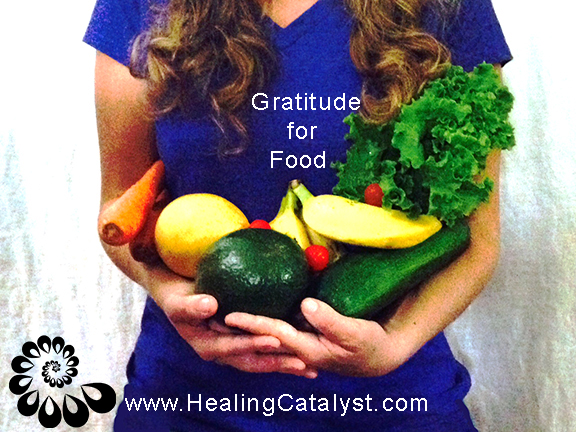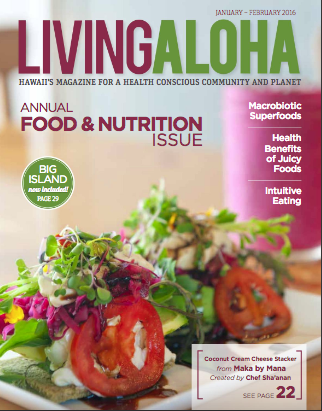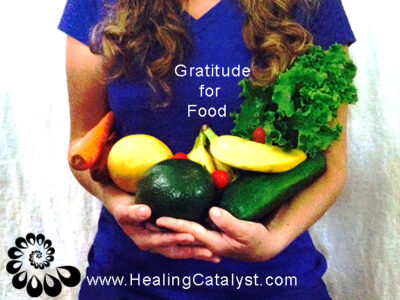The Health Benefits of Gratitude for Your Food
Consider the health benefits of gratitude for your food – not just during the fall holiday but every day. You can even go so far as to think of gratitude as a nutrient, like a condiment to sprinkle on your food to make it assimilate and taste better.
Nothing would be more tiresome than eating and drinking if God had not made them a pleasure as well as a necessity. ~ Voltaire
 Why have Gratitude for Food?
Why have Gratitude for Food?
First of all, you can’t live without it. Think about that again for a moment: you can’t live very long without food. If that’s not cause for gratitude, I don’t know what is. Beyond that, feeling grateful puts you in an open-hearted and receptive state – which improves digestion, heart health, and overall relaxation. Consistently giving thanks is a great way to both give and receive ongoing energetic, social, and even digestive gifts.
In slowing down as you eat and savoring the flavors, you give yourself time to fully take in the nutrients and energy in your food. You can amplify this effect by sharing your food with someone who doesn’t have as much or treating yourself to something extra-delicious and good for your body. To dial it down even further, appreciate the soil microbes and the work they do to nourish and transform the soil – that nourishes your food, that nourishes you! Opening to the wonder of it all opens your body to receive your food with love.
Connect back to basics
We are part of an amazing and complex food web we would do well to appreciate and connect with. Take bees as an example. I first fell in love with bees when I first learned about their waggle dance in first grade and even now, thinking of bees makes my heart open. Bees are amazing and deserve our support and gratitude. Without the work of bees pollinating the plants, most of the food we eat would simply not exist. And don’t forget gratitude for the hands that cultivate, gather, transport and prepare our food.
Growing and preparing food used to take up the majority of people’s time and energy. These days, we can buy prepared food or eat “out,” which gives us more time to be productive in other ways. Eating healthy food made with love, and eating it with others in appreciation is still the best way to take in your nutrients; it feeds your heart, soul, and stomach. It used to be – and it still is in many parts of the word – that your only choice was to eat what is grown nearby, when the season serves it up. Now we have huge supermarkets with shelves full of food from all over the world. We also have a resurgence of local farming communities that provide organic food grown with love. Whatever your food philosophy, whatever the source, take a moment to appreciate the food you eat and the edible bounty of choice that you enjoy.
How you eat your food matters – with Gratitude as nutrient
The longer I live, the more I feel that how I eat is as important as what I eat. Every chance I get now, I sit down and take a deep breath before picking up anything. I appreciate the colors, give thanks to the beings who contributed to the food on my plate, and feel grateful for the whole process. That sets the stage for good assimilation, and then the enzymes in my saliva can begin the physical process of breaking down the food. When I do this, I eat more slowly and enjoy the whole process more; plus, I stop eating before I’m over-full. I know I’m giving myself the benefit of better digestion and relaxation. Since I eat good food, I want to get my time and money’s worth by assimilating it well.
Don’t leave out the fun! Eati with your fingers whenever appropriate. That’s how you are before you could hold a fork properly. It also brings you back into your body and beckons you to delight in the colors, tastes and textures of your food. Glorious food! Imagine wiping up a delicious sauce with bread and popping it into your mouth, or licking the juice of a perfectly-ripe peach off your fingers. Touching your food can add the benefit of sensual pleasure to the nutrients it provides.
It’s so beautifully arranged on the plate – you know someone’s fingers have been all over it. ~ Julia Child
The Roots of Culture
We think of a person’s culture as including shared customs, traditions, food, clothes, beliefs, and rituals. But historically, culture also included the particular microbes a people shared and used to make bread, cheese, sauerkraut, and other pro-biotic foods. Part of a girl’s dowry was the bacterial culture she got from her mother/family and carefully brought with her to use and share in her new, married life. She literally bought her culture with her. This culture was important for the health of all the people who shared and ate from it.
I started culturing coconut water and making my own sauerkraut to improve my digestion. As an added benefit, I’m having fun with the new relationship I have with coconuts, cabbage, and the microbes that turn them into pro-biotic food. As I prepare a new batch, I beam gratitude at the little creatures that make the coconut water effervescent or transform the cabbage into something even more nutritious. This simple process of cultivation connects me to the time before food additives and soil depletion and feeds my soul as well as my body.
Fun Food Facts
- Aztecs used chocolate as a currency.
- The twists in pretzels are meant to look like arms crossed in prayer.
- Apples float in water because 1/4 of their volume is air.
- Cucumbers are 96% water – the most thirst-quenching food. (Watermelons rank second, at 92%.) Water is the most quenching liquid.
- There are more than 7,200 varieties of apples grown in the world.
- Lettuce is a member of the sunflower family.

Food facts source: http://www.thefactsite.com/2012/02/100-random-food-facts.html

